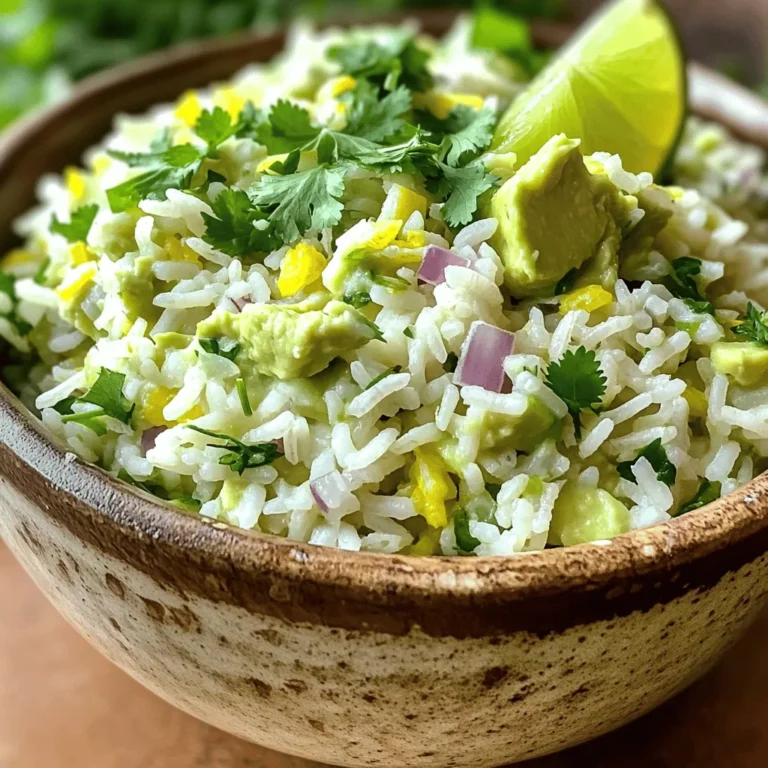One-Pan Greek Chicken and Potatoes Flavors Unleashed
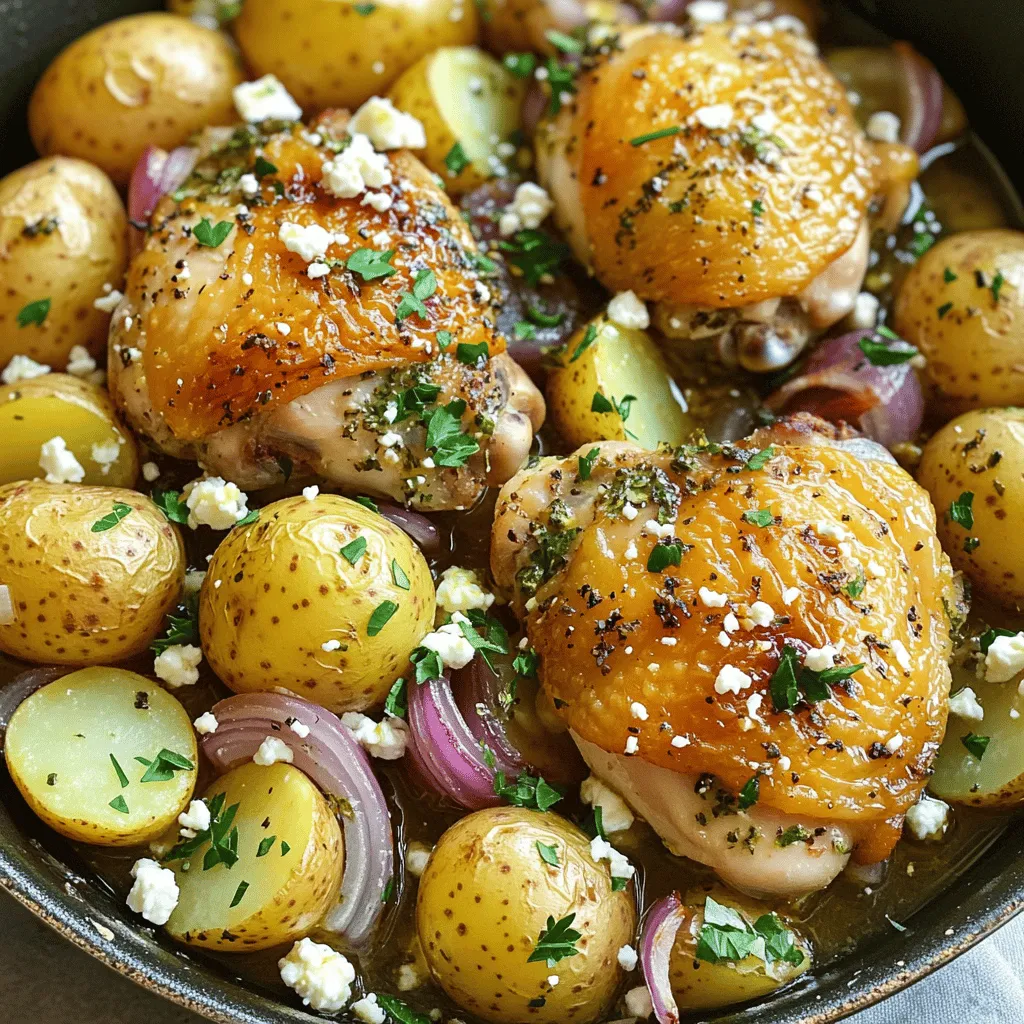
If you crave bold flavors and easy cooking, you’ll love this One-Pan Greek Chicken and Potatoes recipe. With fresh herbs and savory spices, this dish is simple yet satisfying. I’ll guide you through the must-have ingredients, helpful tips, and how to get that perfect crispy skin. Get ready to dive into flavors that dance on your palate and a cooking process that brings joy to your kitchen!
Ingredients
List of Ingredients
To make One-Pan Greek Chicken and Potatoes, you need:
– 4 bone-in, skin-on chicken thighs
– 1 lb baby potatoes, halved
– 1 red onion, quartered
– 4 cloves garlic, minced
– 2 teaspoons dried oregano
– 1 teaspoon dried thyme
– Zest and juice of 1 lemon
– 1/4 cup extra-virgin olive oil
– Salt and freshly ground black pepper to taste
– Fresh parsley, chopped for garnish
– Feta cheese, crumbled for topping (optional)
Each of these ingredients plays a vital role. The chicken gives a rich, savory taste. Baby potatoes add a nice, creamy texture. The red onion brings sweetness, while garlic gives depth. Fresh herbs like oregano and thyme add that classic Greek taste. Using fresh ingredients really boosts the flavors.
Optional Ingredients
While feta cheese is optional, it can take your dish to the next level. The salty, creamy cheese pairs well with the chicken and potatoes. You can also switch up the herbs. Try adding rosemary or basil for a different twist. A sprinkle of red pepper flakes can add a nice kick too.
Nutritional Information
This dish is both hearty and satisfying. One serving has about:
– Calories: 450
– Fats: 25g
– Proteins: 30g
– Carbs: 30g
To make it healthier, use skinless chicken thighs or reduce the olive oil. If you want to indulge, add more feta or serve with crusty bread. Enjoy the balance of flavors while keeping an eye on nutrition!
Step-by-Step Instructions
Preparation Steps
First, let’s prep our chicken and veggies. You need to start by gathering all your ingredients. This step makes cooking smooth and easy.
1. Preheat your oven to 425°F (220°C). This helps get everything ready for roasting.
2. In a small bowl, mix the olive oil, lemon juice, lemon zest, minced garlic, oregano, thyme, salt, and pepper. Whisk this until it’s all combined. This mixture is our marinade.
3. In a large bowl, add the halved baby potatoes and quartered red onion. Drizzle half of the marinade over them. Toss gently to coat well.
4. In another bowl, place the chicken thighs. Pour the rest of the marinade on top. Make sure every piece of chicken gets coated. This step adds great flavor. Marinating helps the chicken absorb all those tasty spices.
Cooking Instructions
Now, let’s cook our dish!
1. Heat a large oven-safe skillet over medium-high heat. When it’s hot, arrange the marinated potatoes and onions at the bottom.
2. Place the marinated chicken thighs skin side up on top. This allows the skin to get crispy while cooking.
3. Transfer the skillet to your preheated oven. Bake for 40-45 minutes. The chicken should be golden brown and cooked through. The potatoes should be tender when you poke them with a fork.
To ensure even cooking, check the chicken and potatoes halfway through. If one side seems to cook faster, you can rotate the skillet.
Broiling for Extra Crispiness
Want that perfect crispy chicken skin? Broiling is the trick!
1. After baking, switch your oven to broil for the last 3-5 minutes. Keep a close eye on it. Chicken can burn quickly under the broiler.
2. Watch for that golden color to develop. This extra step adds a delightful crunch to your meal.
By following these steps, you’ll create a dish full of flavor and joy.Enjoy every bite!
Tips & Tricks
Cooking Tips for Success
To make sure your chicken is juicy, use bone-in, skin-on thighs. This keeps the meat moist. Pat the chicken dry before marinating. It helps the flavors stick better. For tender potatoes, cut them in halves. This allows them to soak up the marinade well. Mix the marinade in a bowl before adding it to the chicken and veggies. This way, every bite bursts with flavor.
Serving Suggestions
Serve your Greek chicken and potatoes with a fresh salad. A simple cucumber and tomato salad pairs nicely. You can also add a side of crusty bread. This helps soak up the tasty juices. For a beautiful look, serve directly from the skillet. Add lemon wedges around the edge. A sprinkle of parsley gives it a pop of color. If you like, top with crumbled feta cheese for extra flavor.
Common Mistakes to Avoid
One common mistake is not marinating long enough. Marinate the chicken for at least 30 minutes. This allows the flavors to penetrate. Also, avoid overcrowding the pan. If the chicken and potatoes are too close, they won’t roast properly. If your chicken is undercooked, check the temperature. It should reach 165°F (75°C) in the thickest part. For vegetables, they should be fork-tender. If they are hard, give them more time in the oven.
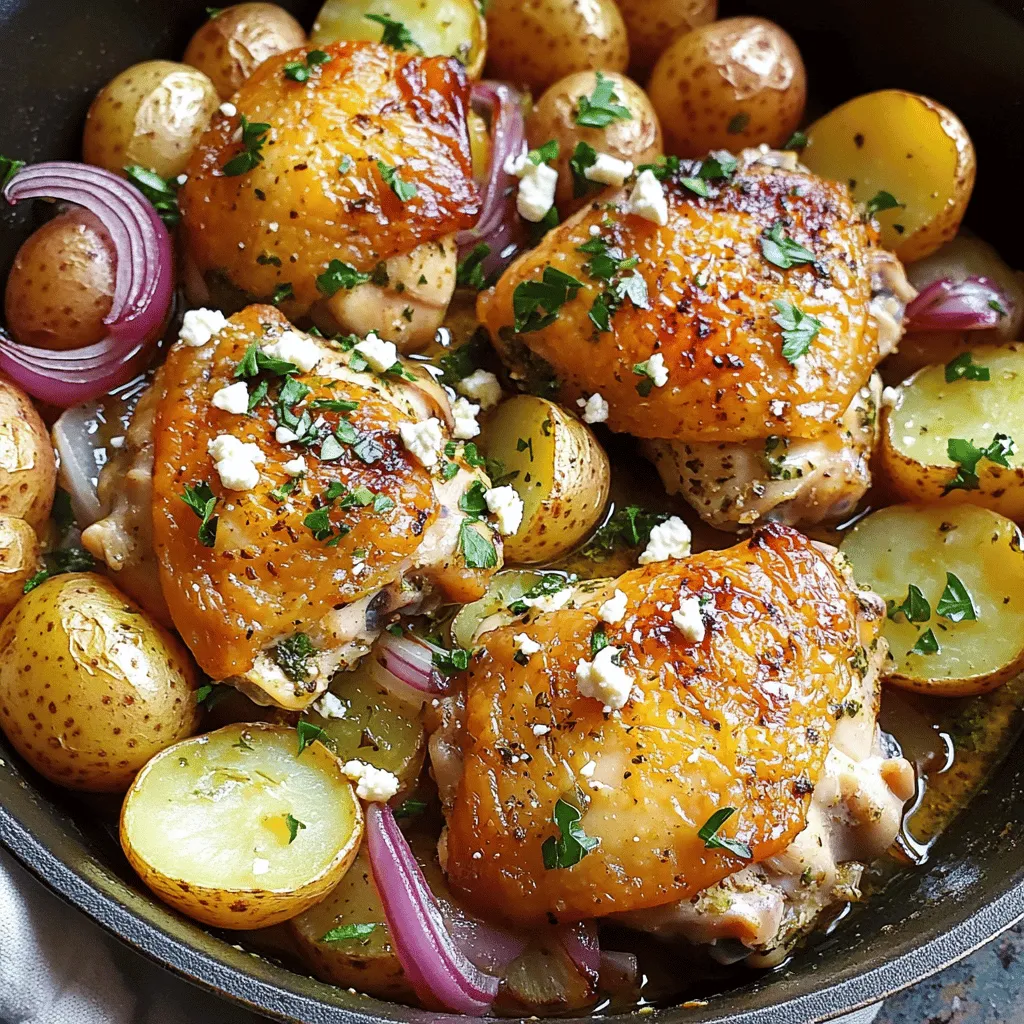
Variations
Ingredient Substitutions
You can switch up the main ingredients in this dish. Instead of chicken, try using fish like salmon or cod. These options cook quickly and soak up the flavors well. For potatoes, consider sweet potatoes for a sweeter taste and more nutrients.
You can also change the herbs in the recipe. Try using Italian seasoning for a new twist. Fresh herbs like basil or rosemary can bring a bright taste.
Regional Variations
This dish can adapt to local flavors. For a Greek twist, add Kalamata olives or artichokes. They add a nice saltiness and depth. You can also use local veggies, like zucchini or bell peppers, for a fresh touch.
You might experiment with spices too. A sprinkle of sumac can give a citrusy flavor. This adds to the Mediterranean vibe.
Dietary Options
If you want a gluten-free version, this recipe is already a great choice! All the ingredients are naturally gluten-free. Just ensure your seasonings are also gluten-free.
For a dairy-free meal, skip the feta cheese topping. You can add avocado for creaminess instead.
If you’re looking for a vegan option, replace chicken with chickpeas or tofu. Marinate them just like the chicken. This makes for a hearty, plant-based meal that still packs flavor.
Storage Info
Leftovers
Store your leftovers in an airtight container. Place them in the fridge right after the meal. The chicken and potatoes stay tasty for up to three days. The flavors will blend well and create a delicious bite.
Reheating Instructions
For the best taste, use the oven or a skillet to reheat. Preheat your oven to 350°F (175°C). Place the chicken and potatoes in a baking dish, cover with foil to keep moisture in, and heat for about 20 minutes. If you use a microwave, heat in short bursts, checking every minute. This helps keep the chicken juicy.
Freezing Tips
You can freeze this dish for later. Cool it completely before packing it into a freezer-safe container. Make sure to label the container with the date. It can last up to three months in the freezer. To thaw, move it to the fridge overnight. When ready, reheat in the oven or skillet to restore its crispy texture. Enjoy the flavors of One-Pan Greek Chicken and Potatoes even after a few weeks!
FAQs
What is the best way to marinate chicken?
To marinate chicken well, use a simple mix of olive oil, acid, and spices. I recommend marinating chicken thighs for at least 30 minutes. For deeper flavor, let it sit in the fridge for up to 24 hours. Make sure to coat the chicken evenly. This allows the flavors to soak in and keeps the meat juicy. Don’t forget to cover it to avoid any mess.
Can I make this dish in advance?
Yes, you can make this dish in advance. Prep the chicken and veggies the day before. Store them in the fridge with the marinade. When you are ready to cook, just pop it in the oven. This method keeps flavors strong and saves time. Just be sure to let it sit at room temp for 15 minutes before cooking.
What can I substitute for baby potatoes?
If you can’t find baby potatoes, try using regular potatoes or sweet potatoes. You can also use carrots or turnips for a tasty twist. Just cut them into similar sizes for even cooking. This keeps the dish hearty and full of flavor.
How do I know when the chicken is fully cooked?
The best way to check chicken doneness is by using a meat thermometer. The safe internal temperature is 165°F (74°C). You can also check visually. The juices should run clear, and the meat should not look pink. If you cut into the chicken and it is juicy, you are good to go!
What are some good side dishes to serve with this recipe?
This dish pairs great with fresh salads or grain sides. A simple Greek salad with cucumbers, tomatoes, and feta works well. You can also serve it with quinoa or rice for a filling meal. These sides add freshness and balance to the rich flavors of the chicken and potatoes.
In summary, we’ve covered key ingredients for a tasty dish, including the power of fresh flavors. We explored preparation and cooking steps, stressing marinating and ensuring even cooking. I shared helpful tips for success and common mistakes to avoid. Plus, we looked at tasty variations and how to store leftovers properly. Keep experimenting with ingredients and techniques. Cooking is an art, so enjoy the process! You’ll find that small changes can make a big difference in your meals.
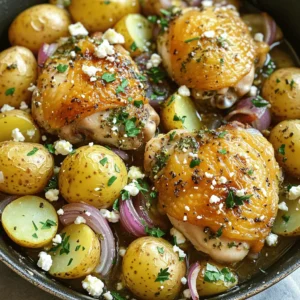

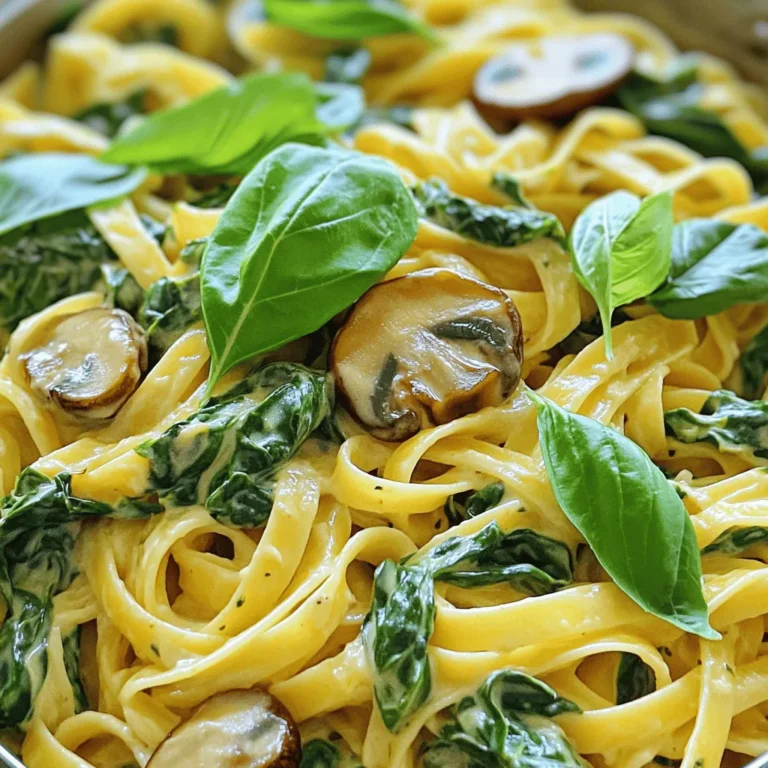
. In this post, we covered essential ingredients for cornbread, substitutions, and tips for fresh picks. I shared step-by-step instructions to ensure your cornbread turns out great. We discussed ways to perfect texture, enhance flavor, and explore different variations. Proper storage and reheating tips help keep your cornbread fresh for later. Remember, cornbread can be sweet or savory, so choose what you love. Get creative and enjoy the process! Your next batch will be delicious and fun to make.](https://goldendishy.com/wp-content/uploads/2025/07/3215032b-f688-44a5-9882-4fc644314e18-768x768.webp)
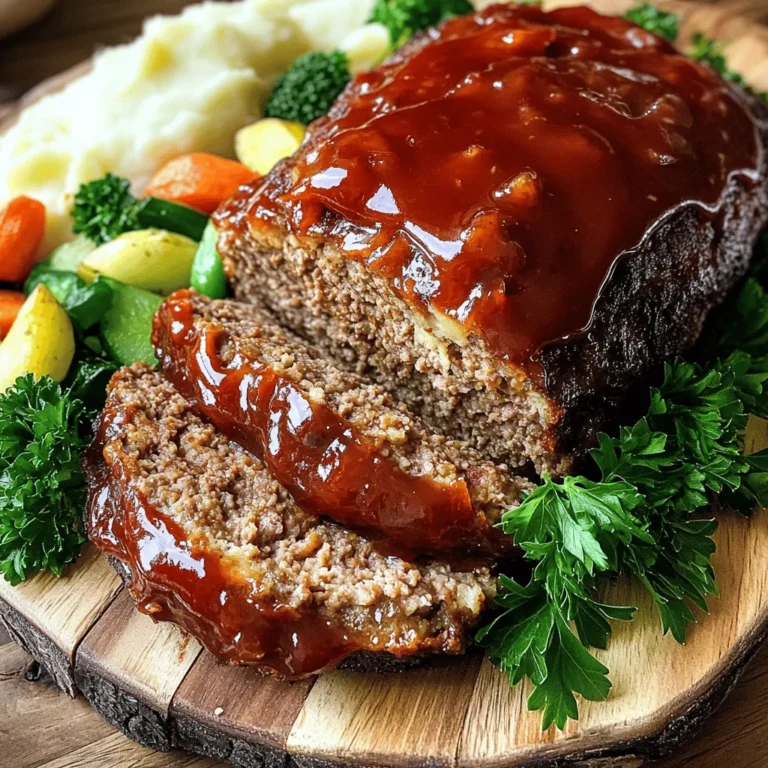
![- 1 large head of cauliflower, cut into bite-sized florets - 1 cup shredded sharp cheddar cheese - 1/2 cup grated Parmesan cheese, divided - 1 cup heavy cream - 2 cloves garlic, finely minced - 1/2 teaspoon smoked paprika - 1/2 teaspoon freshly ground black pepper - 1 teaspoon salt, or to taste - 1/2 teaspoon onion powder - 1/4 cup seasoned breadcrumbs (optional, for added crunch) - Fresh parsley, chopped, for garnish The key to a great cheesy cauliflower bake lies in its simple yet flavorful ingredients. First, you need a large head of cauliflower. Cut it into bite-sized florets. This helps it cook evenly. Next, gather your cheeses. I love using sharp cheddar for its strong taste and Parmesan for a hint of nutty flavor. Heavy cream is a must for that rich, creamy texture. Don't forget the garlic! Mince two cloves finely for a burst of flavor. Seasoning is important, too. Smoked paprika adds warmth, while black pepper and onion powder enhance the dish. If you want a crunchy topping, use seasoned breadcrumbs. They give the bake a nice texture. Finally, finish with fresh parsley. It brings color and freshness. These ingredients come together to create a comforting dish that everyone will enjoy. Check out the Full Recipe for more details! - Preheat the oven to 375°F (190°C). - Boil the cauliflower florets. Start by preheating your oven. This step is key to getting that nice, golden top. While the oven heats, take a pot and fill it with water. Add a pinch of salt. Bring the water to a boil. Once boiling, add the cauliflower florets. Cook them for about 5 to 7 minutes. You want them tender but still a bit firm. Drain the cauliflower and set it aside. - Combine heavy cream, garlic, and spices in a saucepan. - Stir in shredded cheddar and Parmesan cheese until smooth. Now, let’s make the cheese sauce. In a medium saucepan, pour in the heavy cream. Add the minced garlic, salt, black pepper, smoked paprika, and onion powder. Heat it on medium. Stir this mix gently, keeping it warm but don’t let it boil. Once warm, slowly add the shredded cheddar and half of the grated Parmesan cheese. Stir until the cheese melts and the sauce is smooth and creamy. - Mix the cauliflower with the cheese sauce. - Transfer to a baking dish and top with breadcrumbs. In a large bowl, mix the cooked cauliflower with your cheese sauce. Make sure every floret gets coated with that cheesy goodness. Next, take a baking dish and lightly grease it. Pour the cauliflower mixture into the dish. Spread it evenly. If you want a crunchy topping, sprinkle the remaining grated Parmesan cheese and breadcrumbs on top. - Bake until golden brown and bubbly. - Garnish and serve. Place the baking dish in the preheated oven. Bake it for about 20 to 25 minutes. You want the top to be golden brown and bubbly. When it's done, take it out and let it cool for a few minutes. For a nice touch, sprinkle some freshly chopped parsley on top before serving. Enjoy your cheesy cauliflower bake! For the full recipe, refer to the earlier sections. To make the best cheesy cauliflower bake, cook the cauliflower just right. Boil it for about 5-7 minutes. You want it tender but still slightly firm. This helps keep the florets intact when you mix them with the cheese sauce. For the cheese sauce, ensure it is smooth. Stir the heavy cream and garlic over medium heat. Add the cheese slowly while stirring. This will help you avoid lumps. A smooth sauce coats the cauliflower evenly, giving it that creamy goodness. Don't be afraid to experiment with flavors. A little smoked paprika adds a nice touch. You can also try different cheeses. A mix of cheddar and Gruyère can elevate your dish. Using fresh herbs for garnish makes a big difference. Chopped parsley adds color and freshness. You can also use chives for an onion flavor boost. These small touches can turn a great dish into a memorable one. Think about what pairs well with cheesy cauliflower bake. It goes great with roasted chicken or grilled fish. You can also serve it with a crisp salad for added crunch. This dish is perfect for gatherings. Serve it at family dinners or potlucks. It is a great side dish for holidays too. Everyone loves a warm, cheesy treat! For the full recipe, check the instructions above. {{image_4}} You can make this dish lighter with a few easy swaps. - Low-fat cheese options: Try using part-skim mozzarella or low-fat cheddar. - Alternative non-dairy cream substitutes: Use almond milk or coconut cream for a dairy-free choice. These swaps keep the taste rich while cutting calories and fat. Want to spice it up? There are plenty of ways to add flavor. - Adding cooked bacon or sausage for extra protein: Crumbled crispy bacon brings a smoky touch. - Introducing vegetables like spinach or bell peppers: These add color and nutrients to your bake. Feel free to mix and match your favorite proteins and veggies for a unique dish. How you serve this dish can change the experience. - Individual ramekins for portion control: They make for a fun and fancy presentation. - Making it a main dish with protein additions: Pair it with chicken or fish for a complete meal. These options help you customize your cheesy cauliflower bake for any occasion. After enjoying your cheesy cauliflower bake, you might have some leftovers. To keep them fresh, place them in an airtight container. This helps lock in moisture and flavor. You can store the leftovers in the fridge for up to three days. When you’re ready to eat again, just scoop out what you need. Want to save some for later? Freezing is a great option. Cool the dish completely first. Then, transfer it to a freezer-safe container. Make sure to label it with the date. You can freeze it for up to three months. When you’re ready to enjoy it again, thaw it in the fridge overnight. For reheating, you can use the oven. Preheat it to 350°F (175°C). Cover the dish with foil to keep it moist. Bake for about 25-30 minutes, or until heated through. If you want a crispy top, remove the foil for the last 10 minutes. Enjoy your cheesy goodness! For the full recipe, click here [Full Recipe]. Yes, you can prepare cheesy cauliflower bake ahead of time. Start by cooking the cauliflower and making the cheese sauce. After mixing them together, place the dish in the fridge. Cover it tightly with plastic wrap or foil to keep it fresh. When ready to bake, remove it from the fridge. Bake it straight from the cold for about 10 minutes longer than the usual time. This way, you enjoy a warm, cheesy treat without a lot of last-minute work. Cheesy cauliflower bake pairs well with many dishes. Here are some great options: - Grilled chicken: The savory chicken complements the creamy bake. - Steak: A juicy steak adds richness to the meal. - Salad: A fresh garden salad balances the heaviness of the bake. - Roasted vegetables: Crisp, roasted veggies add color and flavor. These side dishes can make your meal feel complete and delicious. Yes! Cheesy cauliflower bake is perfect for vegetarians. It uses cauliflower, cheese, and cream, all plant-based. Just ensure that the cheese options are vegetarian-friendly. Many cheeses are made without animal rennet, making them suitable for vegetarian diets. This dish is a tasty way to enjoy a healthy meal while meeting dietary needs. To sum up, this blog covered how to make a delicious cheesy cauliflower bake. We talked about required ingredients, step-by-step instructions, and tips for great results. You learned about variations, healthy swaps, and how to store leftovers. This dish is not just tasty; it is easy to make and perfect for many meals. Try it yourself for a comforting treat that everyone will enjoy. Remember, the best part is making it your own by adding what you love!](https://goldendishy.com/wp-content/uploads/2025/06/4f60bbbb-6786-4607-99e4-9a4e6c15f60e-768x768.webp)

